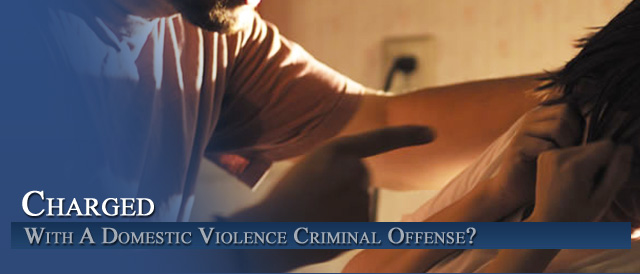




Wrong Thinking Arrest Policies for Colorado Domestic Violence Cases
Introduction – The change in Colorado domestic violence laws and policy has led to the arrest of thousands of individuals pursuant to mandatory requirements – who – only ten years ago – would have their cases mediated by the local police or sheriff. Today – lives have been destroyed – rights lost – as a result of what lawyers call “de minimis” actions. A push, a gentle slap, an annoying action as relates to another’s cell phone. This web page addresses the issues surrounding domestic violence policy and practice in Colorado and across the nation.
Domestic violence is a widespread problem in the United States, endangering the safetyof victims and weakening families. This is the profile of domestic violence:
• Men and women are equally likely to initiate and engage in partner aggression.
• In about half of all cases, the aggression is mutual, meaning that there is no clear-cut initiator of the altercation.
• Although women are more likely to be harmed, males represent 38% of those who suffer an injury from partner aggression.
For many years, advocates have pushed for the strengthening of arrest laws and policies as a deterrent to domestic violence. But these persons have had to overcome a number of legal objections.
In both the Fifth and Fourteenth Amendments, the government is commanded to not deprive any person of liberty “without due process of law.” Arresting a person for allegedly committing domestic violence has a profound impact on personal liberty—men who are arrested for domestic violence are detained an average of nine days.
Arrest has serious legal and social effects as well.
A Substantial Change In Police Discretion
For that reason, police officers traditionally were not allowed to make an arrest for a misdemeanor—most instances of domestic violence are legally classified as misdemeanors—unless the officer actually witnessed the event or had an arrest warrant from a judge. That policy, the hallmark of a civil and just society, served to protect law abiding citizens from arbitrary and unfair arrest.
But over the past two decades, states have enacted domestic violence laws that increasingly departed from these time-honored protections.
Unfairness Driven By The Federal Violence Against Women Act (VAWA)
Driven by the Violence Against Women Act, fundamental notions of due process and equal protection under the law have been turned on their head.
The Evolution of Arrest Policies for Domestic Violence – Mandatory Arrest In Colorado
Over the last 20 years the criteria for arrest have experienced a remarkable evolution.
They have evolved from warrant-required arrest to warrantless arrest, then to mandatory arrest, next to arrest only of the primary aggressor, and more recently back to pro-arrest.
Warrantless Arrests
Originally when law enforcement personnel were summoned for a domestic incident, the most common police responses were to mediate the dispute, recommend a referral for counseling, and/or separate the parties.
Arrest was a relatively uncommon action.
But advocates began to allege police leniency. In response states began to pass laws in the mid-1980s that allowed for so-called “warrantless” arrests for domestic violence cases. These laws still required police officers to have “probable cause” to believe the person they are about to arrest initiated the violence, even though the officer did not actually witness the incident.
But exactly what is “probable cause”?
Probable cause suggests more than a suspicion, but less than a certainty. The broad latitude of the concept renders probable cause open to a wide range of interpretations. In particular, the vague meaning of probable cause places law enforcement personnel in a difficult situation, especially when neither party has suffered a visible injury.
Subjectivity Rules
That subjectivity was revealed at one judicial education seminar where judges were instructed, “So if anybody ever came back at you and said, ‘Well, gee, that’s a real reach in terms of probable cause,’ you have the legislatively mandated response, which is, ‘I erred on the side of caution.’”
Judges: “Better Safe Than Sorry”
In other words, judges were advised to flatly discard the notion of probable cause in favor of the decidedly non-legal notion of “better to be safe than sorry.” Nonetheless, advocates continued to push for warrantless arrest laws, citing a Department of Justice study from the mid-1990s that revealed the police arrested the suspected abuser in only 20% of domestic cases. And eventually they succeeded. By 2000, advocates had persuaded the legislatures of all 50 states to enact such statutes.
Requests for Police Assistance Increased After VAWA
Passage of the Violence Against Women Act in 1994 triggered an increase in calls for police help. The Department of Justice National Crime Victimization Survey (NCVS) revealed that female victims of intimate violence became more likely to report partner assaults to the police over a four-year period:
• 1993: 48%
• 1994: 50%
• 1995: 53%
• 1996: 56%
Unfortunately, the DOJ survey did not provide corresponding information for male victims. It is interesting to note, however, that the 1985 National Family Violence Survey found that women were nine times more likely than men to call for police help, even though women were just as likely to initiate the aggression.
Obviously, the more often police are summoned, the more arrests will be made.
Mandatory and Pro-Arrest Policies
One of the key provisions of the 1994 Violence Against Women Act went beyond merely allowing police officers to make warrantless arrests. VAWA now began to actually encourage such arrests. That represented a complete departure from the traditional legal presumption of “innocent until proven guilty.”
Now the assumption became, “guilty unless proven innocent.”
Relying on VAWA funds, states began to pass mandatory and pro-arrest laws:
• Mandatory arrest requires a police officer to detain a person based on a probable cause determination that an offense occurred and that the accused person committed the offense. Thus the standard normally reserved for felonies began to be applied to misdemeanors.
• Pro-arrest laws consider arrest the preferred, but not required action. An officer who fails to make the arrest must then file a written incident report justifying why no arrest was made.
Male An Arrest Or Get “Jammed Up”
One female officer revealed the dilemma of mandatory arrest policies: “If we don’t make the arrest, even if it’s against our instincts, if something should happen, or if somebody else is reading the case and disagrees, you could be jammed up big-time.”
Mandatory arrest laws do not distinguish between one-time vs. chronic, or minor vs. severe violence. In one Wisconsin case, a woman who slapped her 18-year-old son was detained because he “sassed her and made an obscene gesture.” Courts soon found themselves flooded with cases involving shoving, hair-pulling, and even yelling.
One former prosecutor in Hamilton County, Ohio, complained, “In the past, the officers would intervene or separate the parties to let them cool off. Now these cases end up in criminal courts.
It’s exacerbating tensions between the parties, and it’s turning lawabiding citizens into criminals.”
Jurisdictions responded to their rapidly-growing domestic violence docket with two strategies: establish fast-track prosecution and adjudication procedures, and implement the primary aggressor concept.
Dual Arrests and Primary Aggressor
Studies have repeatedly documented that in at least half of all cases, partner aggression is mutual. For example, a recent survey of dating couples in the United States found that 70% of couples who engage in violence do so on a mutual basis.
Not surprisingly, mandatory-arrest triggered sharp increases in the number of arrests of both men and women. In New Jersey, enactment of a mandatory arrest law increased arrests for domestic violence by 33%.14 In California, mandatory arrest policies caused the number of arrests of men to increase by 37%, while the number of women arrested soared by 446%.15
Hirschel and Buzawa examined the number of domestic violence arrests as a percentage of all incidents reported to the police in a number of jurisdictions. Before pro-arrest laws and policies, DV arrests represented 7-15% of all arrests; afterwards they rose to over 30% of all such incidents.
But advocates began to complain that the law was being enforced too aggressively. They argued that women who were arrested were being “re-victimized” by the system, seldom mentioning that false arrests of men might also be of concern.
The Decline of DUAL ARRESTS
In response to these concerns, the DOJ Violence Against Women Office modified its grant requirements. Application kits for VAWA funding began to claim that dual arrests “trivialize the seriousness of domestic violence and potentially increase danger to victims,” so grant recipients would need to “demonstrate that their laws, policies, or practice and their training programs discourage dual arrest of the offender and the victim.”
As a result of these new requirements, the concept of the “primary aggressor” was introduced. As a result, 24 states now have primary aggressor laws: Alabama, Alaska, California, Colorado, Florida, Georgia, Iowa, Maryland, Missouri, Montana, Nevada, New Hampshire, New Jersey, New York, Ohio, Oregon, Rhode Island, South Carolina, South Dakota, Tennessee, Utah, Virginia, Washington, and Wisconsin.
Which raises the important question, How does a police officer responding to a call determine who is the primary aggressor?
The Alabama Coalition Against Domestic Violence developed these criteria:
1. Likelihood of future injury
2. Whether one of the persons acted in self-defense
3. Prior complaints of domestic violence
4. Relative severity of injuries to each person
5. Physical strength of the parties
But these considerations are riddled with legal and practical flaws:
1. Based on a quick assessment of the situation, how is an officer supposed to determine the likelihood of future injury?
2. How can the officer determine who acted in self-defense, unless there was an objective eyewitness to the event?
3. Knowing that women are far more likely than men to summon help, relying on the record of prior complaints typically disadvantages the man.
4. Relative severity of injuries may not be a good indicator of who is the primaryaggressor, since a victim may retaliate with greater force.
5. Since women are just as likely as men to instigate DV, relying on the determination of physical strength is almost as arbitrary as relying on skin color or hair length.
The New Hampshire Department of Justice established a Law Enforcement Protocol that provides this advice:
When the officer has probable cause to believe that the persons are committing or have committed abuse against each other, the officer need not arrest both persons, but should arrest the person whom the officer believes to be the primary physical aggressor. In determining who is the primary physical aggressor, an officer shall consider the intent of the statute to protect victims of domestic violence, the relative degree of injury or fear inflicted on the persons gastrointestinal involved and any history of domestic abuse between these persons, if that history can reasonably be ascertained by the officer.
The New Hampshire criteria are similar to those in the Alabama list, except that the concept of “fear” is introduced. But experience reveals that men may be adept at hiding their fears.
Primary Aggressor Is A Form of “Profiling
The primary aggressor concept becomes a form of gender profiling, as the following case illustrates:
Susan Finkelstein and her boyfriend got into a heated argument while riding in the car. The argument escalated, so he pulled over to get out and walk home. She scratched him and he pushed her. The police spotted the incident and began to arrest the man. Finkelstein told the officer that she was as much the aggressor as her boyfriend in their altercation. The officer responded that policy required arresting the larger of the two parties.
Current Status of Arrest Provisions
As of 2004, the following 22 jurisdictions had implemented mandatory arrest laws:
Alaska, Arizona, Colorado, Connecticut, District of Columbia, Iowa, Kansas, Louisiana, Maine, Mississippi, Nevada, New Jersey, New York, Ohio, Oregon, Rhode Island, South Carolina, South Dakota, Utah, Virginia, Washington, and Wisconsin.
In the following eight states, arrest is preferred but not mandated: Arkansas, California, Florida, Massachusetts, Michigan, Montana, North Dakota, and Tennessee.
As a result of the problems outlined above, the 2005 Violence Against Women Act mollified its position to promote pro-arrest rather than mandatory arrest policies. It is now estimated that each year about one million persons are arrested under criminal law for intimate partner violence,1 of whom 77% are male.24 A disproportionate number of arrestees are Black.
Ineffective at Best, Harmful at Worst
For some, the civil liberties concerns that surround mandatory arrest are still justifiable if, in fact, mandatory arrest can be shown to substantially reduce offender recidivism. Initial evaluations conducted in six states suggested that mandatory arrest initially deterred violence in employed men, but not among unemployed men. But in the long run, the incidence of physical abuse actually increased.
Furthermore, surveys of abused women reveal higher satisfaction with police actions when the officers complied with the woman’s request that they not arrest the alleged offender. In many cases the woman does not want the offender to be arrested; she just wants to stabilize the immediate situation. In light of these findings, the original research team that evaluated mandatory-arrest policies concluded that the policies should be repealed.
Christopher Maxwell and colleagues then examined evidence from five jurisdictions.
They found that, according to police records, for 70% of men, whether they were arrested or not did not affect subsequent assaults on their wives or girlfriends. And the 8% of men who engaged in chronic domestic violence did not seem to be deterred by having been arrested.
Recently Harvard economist Radha Iyengar analyzed the impact of the passage of mandatory arrest laws in 15 states. Her conclusion: “Intimate partner homicides increased by about 60% in states with mandatory arrest laws,” which means that, “Mandatory arrest laws are responsible for an additional 0.8 murders per 100,000 people.”
Thus, the weight of evidence reveals mandatory arrest policies are often harmful. And female abuse victims indicate a preference to have some say over whether an arrest is made. As the Ms. Foundation for Women notes, victims want their voices to be heard, not silenced.
Arrests for Violations of Civil Restraining Orders
Civil and criminal laws were traditionally regarded as being separate and distinct. A civil offense was viewed as a lesser infraction that was committed against an individual citizen. In contrast, a criminal offense was an action committed against both an individual and society.
A person charged with a criminal offense is subject to greater penalties, in particular, incarceration. Accordingly, the accused is also entitled to greater protections, including free legal counsel, trial by jury, and a higher level of proof required to convict–clear and convincing evidence, not just a preponderance of evidence.
But domestic violence laws blur the distinction between a civil and criminal offense. The 2-3 million domestic restraining orders issued each year underscore this problem. Restraining orders are issued under the aegis of civil law, so a temporary restraining order can be granted less regard for due process protections. But the violation of arestraining order issued for a civil offense carries the penalty of arrest, which is a criminal penalty. That’s like arresting someone who didn’t pay a traffic ticket and putting him in jail.
The problem worsens when persons inadvertently engage in minor or technical infractions of restraining orders. A rigid one-size-fits-all mandate overrides the commonsense discretion of police officers and judges:
Harry Stewart, a Massachusetts lay minister and father of two, dropped off his 5-year-old son at the home of his ex-wife. He got out of the car to help open the front door to the apartment building, even though the restraining order required him to stay in his car when dropping off his children. When he later refused to sign a “confession” stating that he was a batterer, Mr. Stewart was forced to serve a 6-month sentence.
According to Hirschel and Buzawa, the following 33 states have laws that mandate arrest for violation of a restraining order: Alaska, California, Colorado, Delaware, Iowa, Kansas, Kentucky, Louisiana, Maine, Maryland, Massachusetts, Minnesota, Mississippi, Missouri, Nebraska, New Hampshire, New Jersey, New Mexico, New York, North Carolina, North Dakota, Oregon, Pennsylvania, Rhode Island, South Carolina, South Dakota, Tennessee, Texas, Utah, Virginia, Washington, West Virginia, and Wisconsin.
These cases represent a significant number of all criminal DV cases. One analysis in New York City found that 15% of all domestic violence cases that went to criminal court involved criminal contempt, typically arising from restraining order violations.
A Double Standard for Arrest
The Equal Protection Clause of the U.S. Constitution directs law enforcement personnel to enforce the law without bias or pre-conception. But cases have been reported of police officers who failed to take appropriate protective measures for male victims.
In one California case, a father of two was married to a physician who was physically abusive to him. On several occasions he called the police, but although they took a report each time, they refused to arrest her. On one occasion, she fractured one of his ribs with her kicks and then beat him over the head with his cell phone, causing him to bleed. But when the police arrived, they refused to arrest the woman, telling the man, “We ain’t taking no report from you, buddy.”
In another case, as a man opened the door into his house, his wife hit him over the head with a frying pan, causing a large gash. When the police arrived, they acted as if it were a joke. When the man said he planned to file a complaint, the officer replied, “There’s nothing to press charges on. She’s half your size. The judge won’t even look at it.”
In some cases, the civil rights concerns double when the police first refuse to arrest the female perpetrator, and then proceed to arrest the male victim: Baltimore Orioles pitcher Scott Erickson was arrested after an altercation with his girlfriend, Lisa Ortiz, in 2002. The local police found that she had initiated the fight by hurling objects that caused injury to Erickson. To prevent further attacks, Erickson carried his girlfriend out of the apartment. Ortiz suffered no injuries during the altercation. Still, the police viewed Erickson’s actions as excessive and charged him with second-degree assault.
Ortiz later admitted that Erickson “has never been physically abusive toward me, and in no way do I feel threatened or have I felt fear from Scott.”
The following case is equally disturbing:
A mentally ill woman attempted to shoot her husband with a shotgun. After the husband succeeded in wresting the weapon away from her, she summoned the police, admitting that she wanted them to come because she wanted to kill her husband. Despite this explicit statement, when the police arrived, they immediately grabbed her husband, wrestled him to the floor, and handcuffed him. They uncuffed him only when the daughter repeatedly explained that it was her mother who had instigated the incident.
Biased Training of Law Enforcement Personnel
The previous examples of law enforcement bias do not appear to be the isolated actions of a few over-zealous police officers. Rather, they stem from ideologically driven training programs and policies.
In Massachusetts, a training manual advises officers to be wary of a male victim’s “excuses” such as, “She hit me first.” In addition, the manual encourages officers to downplay the significance of a man’s injuries, warning that “injury alone doesn’t determine who is the abuser.”
In New Hampshire, the Department of Justice Prosecution Protocol advises officers that alleged DV offenders may claim “to be the victim of an assault by the victim.”
In other words, claiming to be innocent should be interpreted as evidence of guilt.
“You Call, We Haul” Justice
The United States justice system is based on the notion that a person cannot be punished without due process of law. Traditionally, American jurisprudence allowed warrantless arrests only in the event of a serious crime, especially a felony. But domestic violence incidents are generally misdemeanors, which represent a lesser severity of crime. Nonetheless, 29 states and the District of Columbia now have laws that mandate or encourage arrest. As a direct result, hundreds of thousands of persons are arrested each year. This represents a disregard of the principle of innocent until proven guilty.
Abuse advocates justify such policies on the basis that they serve to deter future violence, a belief that is not supported by research data. Perhaps the greatest distortion is VAWA’s stance against dual arrest. First, that policy ignores the reality that half of all partner aggression is mutual. Second, it renders a person unable to defend himself from a violent attack, other than fleeing the scene. Any attempt to restrain the assailant or move her to a safe location is likely to be later construed as the man initiating the assault.
The Violence Against Women Act, and the state laws it has engendered, turns every act of family conflict—a shove, a thrown pillow, or even a sharp word—into a potential crime. The government is now authorized to intrude into the most private affairs of its citizens. Arrests serve to escalate partner conflict and restraining orders deter mediation or partner counseling. As a result, VAWA-driven policies and programs lead to family dissolution.
*Adapted,summarized and attributed to the excellent website RADAR
More Information:












